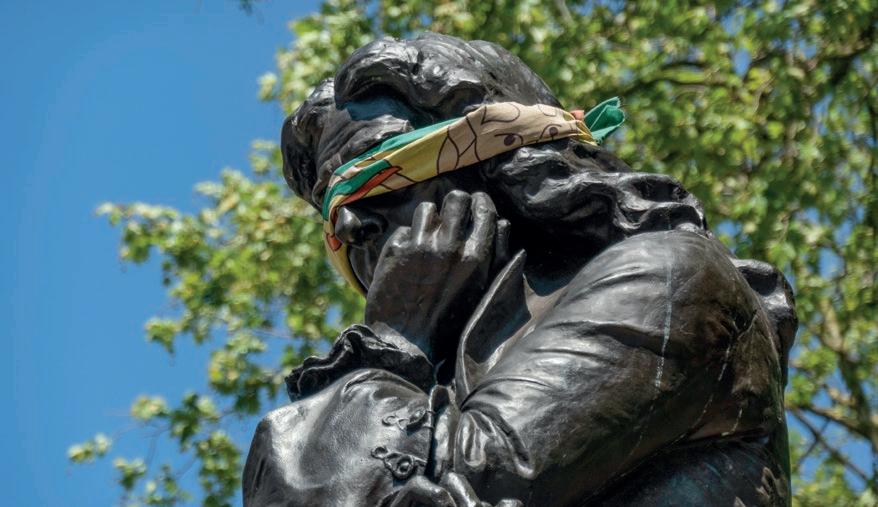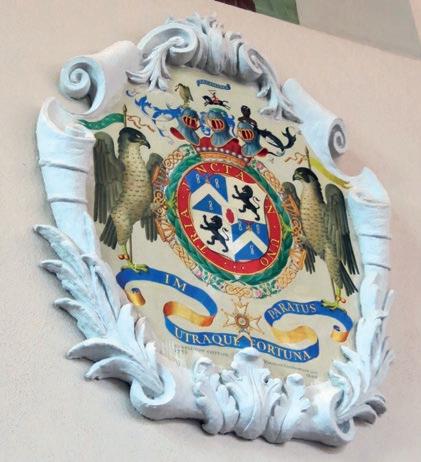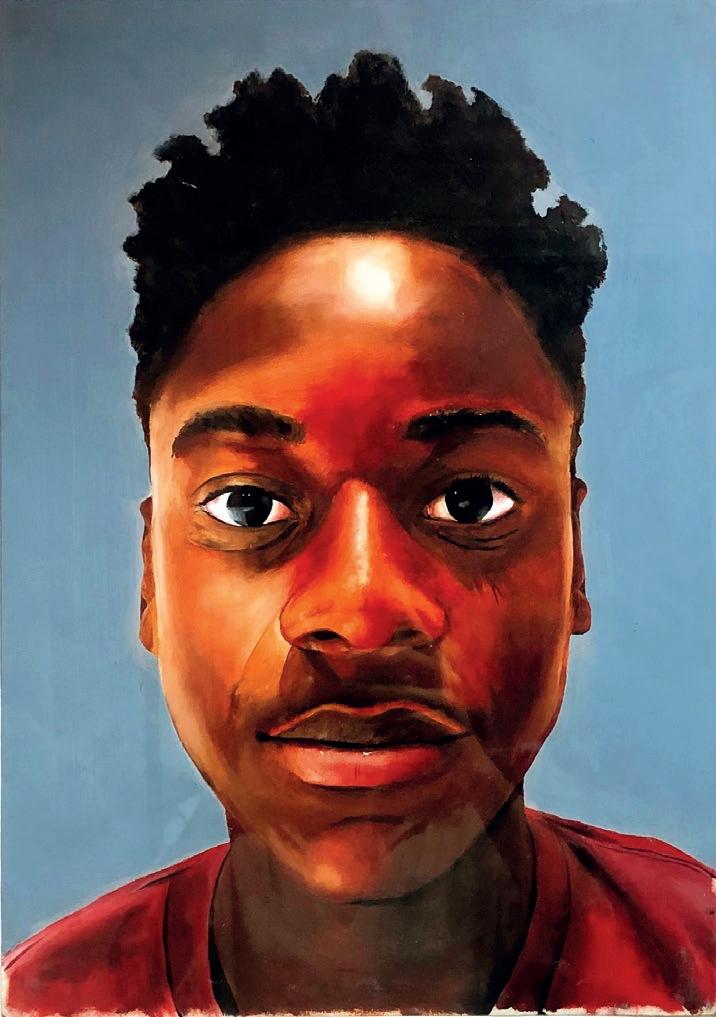
10 minute read
From the Archives
Elizabeth Wells School Archivist
A map from a copy of Hakluyt’s work Divers Voyages in the school’s Greene Collection.
Advertisement
Black Lives Matter
One of the enduring images of the UK’s Black Lives Matter demonstrations will undoubtedly be the toppling of Edward Colston’s statute in Bristol. Many outside of the city would not have known who Colston was until 2020 – but the campaign to modify the statue’s plaque, so that it acknowledged that Colston’s philanthropy was built on trading over 80,000 enslaved people, had been fruitlessly continuing for years. The actions of the crowd were not a spontaneous act of vandalism but an expression of long held frustration.
olston’s statue is the only one in the country to have been removed by protestors, and those responsible have been prosecuted. However, other statues across the country are now being scrutinized. At the time of writing a commission established to assess the legacy of Cecil Rhodes at Oriel College – including whether or not to remove his statue – had delayed its final report, in part due to the weight of submissions received. The Corporation of London is engaged in a dispute concerning a depiction of Old Westminster, William Beckford, at the Guildhall. The government-backed approach of ‘retain and explain’, championed by Historic England, is at odds with the Corporation’s desire to remove the statue.
I have been giving thought to those who are memorialised around the School. Comparatively little of our portraiture was commissioned or purchased by the School, most were gifts. Names have often developed in an organic fashion; Ashburnham House is named after the building in which it was based, rather than in honour of the Earls of Ashburnham. The accretions of history we see around us have developed in a haphazard way. Moreover, even where artefacts were intended to be celebratory, they are not always interpreted in that manner – the mixed reactions to the school’s 450th anniversary statue of Elizabeth I are a prime example. History is a process of constant revision and disputation, not a single static story. The Westminster spirit is one of loyal dissent and I hope we teach all our pupils to approach their environment with a critical eye, especially when it comes to representations of power and wealth.
The other difficulty is summarised by the historian’s adage – ‘absence of evidence is not evidence of absence.’ The philosopher Julian Baggini noted in a recent article that ‘by our current standards, most Britons in history have been misogynist, racist and homophobic,’ whether or not records
Colston's statue, Bristol and above during the Black Lives Matter demonstrations



Caution! of their views have survived. We should not underestimate the cathartic value of removing figures such as Colston, or the impact of our built environment. However, David Olusoga was right to stress that ‘allowing the statues issue to get in the way of the anti-racism debate would be a mistake, and would empower objects that we mostly ignore.’
With these cautionary thoughts in mind, we have begun research into the connections between former pupils and benefactors of the school and the trans-Atlantic slave trade. There are over 26,000 known alumni and thanks to The Record of Old Westminsters, a series of published volumes providing detailed biographical information, we have been able to make some progress in identifying those who owned enslaved people. Our work has depended heavily on UCL’s Legacies of British Slave Ownership online database, which is an excellent resource, but not without limitations. It draws on the documents produced at the point of abolition in 1833 when a number of slave-owners applied for and received compensation from the British state for the loss of their ‘property’ in the Caribbean. Although researchers are working to trace both backwards and forwards from this point, it is primarily a snapshot of the early 19th century. It also focuses on the trans-Atlantic slave trade and does not consider British activities in other colonial theatres.
At the beginning is Elizabeth I, who refounded the School in 1560 and who is celebrated annually at the School’s commemoration of benefactors service and a number of School songs and prayers. There are numerous depictions of her around the school site with the most recent and distinctive being the aforementioned statue in Yard. In ➽
addition to authorising and profiting from the trade of slaves, her reign was also a period of significant catholic persecution.
However, many would argue that in commemorating Elizabeth I at Westminster, we are specifically celebrating her support of the School and commitment to education. It is also worth considering that our depictions of Elizabeth I are some of the relatively few images of women we have in an art collection inevitably dominated by dead white men. The same argument could be made for our bust of Gandhi, on display in the Brock Library, who is a rare person of colour in our collection. Gandhi’s championing of non-violent protest made him an inspirational figure around the world, but he espoused racist views about Black Africans.
Richard Hakluyt has also been highlighted as a problematic figure in the School’s past. Whilst he never travelled outside of Europe himself, Hakluyt was keen to promote the English colonisation of North America, in response to Spanish and Portuguese activities. There is no evidence that he supported slavery or oppression of indigenous people, although these were the outcomes of the colonial enterprise. Whilst Hakluyt’s work was influential, providing inspiration to Shakespeare, he remains a little known and unstudied figure. The suggestion to name the School’s new day house after him in 1987 was made by a then junior English teacher, Richard Pyatt, with a view to shedding more light on this individual.
A letter to the Head Master in the wake of George Floyd’s murder mentioned John Locke’s involvement in drafting the Fundamental Constitutions of Carolina, which stated that freemen in that territory would have ‘absolute power and authority over [their] negro slaves.’ Locke wrote prolifically and his attitude towards slavery has been the subject of intense academic debate for the past 50 years. Defenders of Locke note that his involvement in the Constitutions was as a secretary, paid to draft the legal document but with limited control over its contents. Locke’s own writing specifically opposes this form of slavery and the oppression of indigenous peoples. Of the 89 Old Westminsters featured in UCL’s Legacies of British Slave Ownership Database only one slave owner is represented in the School’s visual environment – Stapleton Cotton, whose arms are amongst those displayed up School. The current decorative scheme was designed by Head Master, John Carleton, in the 1950s, although coats of arms were displayed in the space prior to the Blitz. Cotton was presumably included for his military prowess, but we know that he was also a slaveowner who, in 1833, received compensation for 420 enslaved people on his plantations in St. Kitts and Nevis. I have long been uneasy about elements of the traditional heraldic designs which are on display up School and the

One of the pupil artworks the school selects each year to add to its collection. Stapleton Cotton’s coat of arms up School, with incorrect Latin motto and a ‘blackamoor’ head in the top right.


A portrait of the first eight female scholars at the school, commissioned by the College Society.
Thanks
Thanks to lockdown clear outs we’ve had a bumper crop of donations to the archive – many thanks to all those OWW who have given us their Westminster memorabilia and copies of their publications. Thank you also to those who have donated their time and money towards conservation. We love adding new items to our collections, which are widely used both within and outside of the school. Please keep the donations coming! ‘blackamoor’ – a stylized African head – on this particular coat of arms is a clear example of why these decorations require reconsideration.
Due to the origins of the Black Lives Matter movement in the US, focus has understandably been on proponents of the trans-Atlantic slave trade. However, many controversial episodes in Westminster School’s past relate to British activities in India. Hundreds of Westminster pupils served in the East India Company in the 18th and 19th centuries. I will mention just one – Warren Hastings. Hastings was an employee of the East India Company who rose to become the first Governor General of the country. He was accused of corruption but acquitted after a long trial. Hastings undoubtedly played his part in British exploitation of India, but he also pursued a number of reforms which genuinely improved the lives of Indian citizens. In Zareer Masani’s essay on Hastings he notes that of all the Governor Generals he was ‘undoubtedly the most curious and learned of them all about Indian culture and, judging by contemporary accounts, the most popular among his Indian subjects’.
This period of British history has been glossed over in past decades. In recent years the school has actively tried to shine a spotlight on Hastings. In the 1990s the decision was made to name a room in Ashburnham House the Hastings Room and in 2014 Hastings was selected as one of the Old Westminsters to be profiled in the Head Master’s book ‘Loyal Dissent’. This is not because we wished to place him on a pedestal, but because we felt he was a complex figure, whose study raises important topics deserving of our attention.
Since my arrival at Westminster in 2011 I have been working to ensure that the school’s existing collections are better understood and displayed. Moreover, through initiatives such as purchasing a piece of pupil artwork each year, we are seeking to make the collection more representative of school life today in its full diversity. Moving forward I am keen to use our Oral History programme to record the experiences of pupils at Westminster from Black and other minority backgrounds.
Our research is only just beginning. Over the course of 2021 we are posting monthly articles on our blog which allow more space to investigate stories in detail. Subjects thus far include Robert Dalzell, an eighteenth century pupil whose maternal grandmother was a Black slave; the Beckford family who amassed enormous wealth through ownership of enslaved people and plantations in Jamaica; and William Murray whose legal rulings helped pave the way for abolition and who is now known for the care he showed his niece and ward, the mixed-race Dido Elizabeth Belle. To read more please visit archiveblog.westminster.org.uk. Afua Hirsch has remarked that what we need at this time is ‘more history, not less.’
Some elements of the media are keen to portray the decisions facing us as binary – we either retain all of our statues on their pedestals or erase these figures from history. In this way our past becomes a proxy for the current culture war and can distract from much needed institutional change. We must reject this attempt to polarize debate and approach these difficult subjects with the care and subtlety they deserve. ■
Collections Online
Our electronic catalogue continues to develop and can be browsed and searched at collections.westminster. org.uk. The site contains descriptions – and in some cases digital copies – of works of art, rare books, objects and records. Thanks to time spent working from home over the lockdown we have been able to add biographical information drawn from the first three volumes of The Record of Old Westminsters to the catalogue as well. We appreciate constructive criticism on this resource and are always keen to know which areas of school life you would like to see better represented to help guide future digitisation, transcription and cataloguing.










